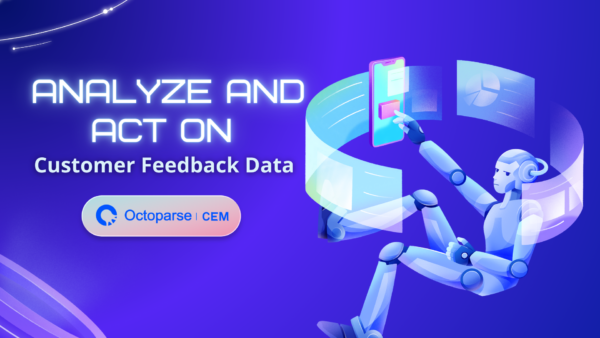Customer service is the direct support businesses offer customers before, during, and after transactions. Excellent customer service is critical to corporate success. As a result of escalating consumer expectations, an increasing number of businesses are focusing on measuring and improving their customer experience to retain customers and drive growth. In this piece, we’ll cover the fundamentals of customer service metrics and how customer experience management (CXM) solutions may help you collect valuable customer experience (CX) data.
Why Customer Service Matters
- Builds trust and loyaltyPositive service interactions build trust between a customer and brand that can make the customer more likely to purchase again and become a loyal advocate for the company.
- Promotes positive brand image: Word-of-mouth and reviews about great service experiences can shape a company’s reputation, attracting new customers who have heard good things.
- Drives sales and revenue: Customers who receive good service are more likely to buy additional products and services which might directly impact sales and revenue growth.
- Reduces customer churn: Dissatisfied customers will simply switch to a competitor if they have a poor service experience. Reducing churn is critical for retaining valuable customers.
- Lowers costs of acquiring new customers: It costs 5-25x more to acquire a new customer than to retain an existing one. Providing good service is an investment in future business.

Key Metrics to Measure Customer Service
Customer Satisfaction (CSAT)
Customer satisfaction (CSAT) is a metric that assesses how happy or satisfied consumers are with a given service encounter or the entire brand experience. It is one of the most common metrics used to gauge customer service quality and performance. With regular CSAT surveys, customer service teams can constantly improve procedures to provide more favorable experiences, resulting in increased loyalty, retention, and income.
Customers are asked to rate their level of satisfaction on a numeric scale, often 1-10 or 1-5, while participating in CSAT surveys. Customers, for example, may respond to questions like “On a scale of 1-10, how satisfied were you with the most recent service you received?” The score indicates how pleased or unhappy they were with their service experience. A higher CSAT score indicates a better customer experience. Companies may then calculate the percentage of pleased consumers by dividing the total positive ratings by the total number of answers and multiplying by 100.
A score of more than 80% is regarded as good, whereas anything less than 60% indicates low customer satisfaction. Companies may determine if their service quality is increasing or worsening by tracking CSAT trends over time.
Net Promoter Score (NPS)
The Net Promoter Score (NPS) is an important measure for assessing customer loyalty and happiness since it helps uncover problems and opportunities to enhance customer experiences. It entails asking clients a single question: “On a scale of 0-10, how likely are you to recommend our company to a friend or colleague?”
Based on their score, customers are grouped into three categories:
- Promoters (9-10): Loyal enthusiasts who will keep buying and referring others.
- Passives (7-8): Satisfied but unenthusiastic customers who are vulnerable to competitive offerings.
- Detractors (0-6): Unhappy customers who can damage your brand through negative word-of-mouth.
The Net Promoter Score is calculated by subtracting the proportion of critics from the percentage of promoters, and it may vary between -100 and 100. An NPS greater than 0 is regarded as acceptable, while one greater than 50 is exceptional.
Customer Effort Score (CES)
The customer effort score (CES) is a metric that measures the ease and convenience of getting customer support. Its goal is to measure the amount of effort a client must exert to have their issue fixed by the organization. The CES is often assessed by asking clients a simple question after they have contacted customer service:
“How much effort did you have to put forth to handle your request?”
The question is often graded on a 5 or 7-point scale, with 1 representing “very low effort” and 5 or 7 representing “very high effort.” A low CES means that clients may readily obtain support and have their problems fixed with little difficulty. This displays effective customer service. A high CES indicates that clients must go through hoops to seek help, implying poor and complicated service.
The CES offers practical recommendations for enhancing customer service. If the CES begins to trend upward, it indicates that consumers are working harder to find help. The organization may then look into why the service has grown more complex and make adjustments. Along with CSAT and NPS, it gives a comprehensive picture of the customer service experience.
Customer Retention Rate
Customer retention rate is the percentage of customers that a company keeps over a specific period, such as month over month or year over year. It demonstrates a company’s capacity to retain existing consumers who purchase and engage with the brand over time.
Customer retention is especially important for subscription-based organizations that generate recurring income. A high, consistent retention rate implies long-term growth, but a declining rate signals a concern. Customer service teams may improve retention by providing prompt, empathic, and effective assistance.
To determine the customer retention rate, divide the number of customers at the end of a period by the number of customers at the beginning. For example, if a SaaS firm had 100 clients at the beginning of January and 90 customers by the end of January, its monthly retention rate would be 90/100 = 90%.
Average Resolution Time
The average resolution time indicates how long it takes for a company to address customer support queries and requests. This measure is crucial since resolution timeliness has a direct influence on customer satisfaction. Customers demand prompt service, and any delays in resolving concerns may harm their opinion of your business.
The shorter the average resolution time, the better the customer experience. Lengthy average resolution times lead to frustrated customers and more repeat contacts to follow up. This increased handle time in turn raises support costs. Quickly resolving customer issues the first time improves efficiency. It also minimizes the need for customers to follow up repeatedly or escalate to management.
Monitoring average resolution time and setting goals for improvement highlight areas where agents may need additional training. Analyzing spikes in resolution time may also reveal systemic issues in business processes that need to be addressed.
How to Gather Customer Service Insights with CXM Software
Voice of the Customer (VoC) Surveys
Voice of the Customer (VoC) surveys are critical for gathering feedback directly from customers about their service experience. Well-designed surveys give customers a channel to provide ratings, feedback, and suggestions. This first-hand data offers insights that can be used to identify strengths and weaknesses in customer service. Also, this data might help companies improve customer satisfaction, loyalty, and brand reputation.
VoC surveys are typically short, simple questionnaires sent to customers after interactions. Common questions cover satisfaction, ease of service, agent helpfulness, and the likelihood of recommendation. Surveys can be automated via email, SMS/text messages, web pop-ups, and more. Automation makes it easy to send surveys at scale after service calls, site visits, purchases, and other touch-points.
Key benefits of VoC surveys for customer service:
- Direct customer feedback on service quality
- Identify areas for improvement
- Track service metrics like CSAT and NPS over time
- Increase response rates via automation
- Aggregate data to spot trends and outliers

Analyze Support Interactions
Analyzing transcripts of customer support calls, live chat logs, and emails can provide tremendous insights into pain points and opportunities to improve service. By reviewing these raw interactions, companies can identify common themes and problems that customers frequently encounter.
For example, if multiple customers are contacting support because they are confused about how to cancel their account, then the cancellation process needs to be simplified. Or if customers are consistently complaining about long hold times, more support staff may need to be hired.
Analyzing support interactions makes it easy to pinpoint the most common pain points that customers experience. Whether it’s difficulty using a certain product feature, billing issues, or other problems – these pain points will be quickly evident by reviewing transcripts and logs. For example, they may change their product design, update help documentation, tweak their policies, or take other actions to alleviate the top issues.
Social Media Monitoring
Social media monitoring tools allow brands to track mentions of their company, products, and services across social platforms. By setting up keyword alerts, brands can be notified anytime they are mentioned on social media. Natural language processing can analyze the sentiment of mentions, classifying them as positive, negative, or neutral. Monitoring tools also compile useful analytics, like top keywords and influencers talking about your brand.
Some key ways social listening provides customer service insights:
- Identify recurring complaints or service issues. If multiple customers complain on social media about long wait times or unhelpful agents, this signals a systemic issue to address.
- Resolve problems for angry customers. Monitoring helps brands find dissatisfied customers and reach out to resolve their issues before they spread negative word-of-mouth.
- Analyze sentiment data over time. Track if sentiment towards customer service is improving or declining month-over-month.
- Pinpoint brand advocates. Identify social media users who frequently share positive experiences to highlight or potentially partner with as influencers.
- Gather feedback on new products. Monitor social chatter after a product launch to gauge initial reactions and customer feedback.
Session Replays
Session replays allow you to record and review actual customer journeys through your website or app. They are a powerful complement to VoC surveys and support analytics. While surveys gather subjective feedback, replays offer objective data on real customer behaviors. Together, these insights help you measure and continuously improve customer service.
With session replays, you can see exactly where customers are struggling to find information or complete key actions like checkout. Watching the recordings lets you identify usability issues that may not be discovered through surveys alone. For example, you may notice customers hesitating at a certain page, rapidly clicking buttons, or exiting the site altogether. This signals confusion or difficulty with the interface. Session replays shine a spotlight on these pain points.
Wrap Up
Customer service is the direct support businesses offer customers before, during, and after transactions. Excellent customer service is critical to corporate success. As a result of escalating consumer expectations, an increasing number of businesses are focusing on measuring and improving their customer experience to retain customers and drive growth. In this piece, we’ll cover the fundamentals of customer service metrics and how customer experience management (CXM) solutions may help you collect valuable customer experience (CX) data.
Why Customer Service Matters
- Builds trust and loyaltyPositive service interactions build trust between a customer and brand that can make the customer more likely to purchase again and become a loyal advocate for the company.
- Promotes positive brand image: Word-of-mouth and reviews about great service experiences can shape a company’s reputation, attracting new customers who have heard good things.
- Drives sales and revenue: Customers who receive good service are more likely to buy additional products and services which might directly impact sales and revenue growth.
- Reduces customer churn: Dissatisfied customers will simply switch to a competitor if they have a poor service experience. Reducing churn is critical for retaining valuable customers.
- Lowers costs of acquiring new customers: It costs 5-25x more to acquire a new customer than to retain an existing one. Providing good service is an investment in future business.

Key Metrics to Measure Customer Service
Customer Satisfaction (CSAT)
Customer satisfaction (CSAT) is a metric that assesses how happy or satisfied consumers are with a given service encounter or the entire brand experience. It is one of the most common metrics used to gauge customer service quality and performance. With regular CSAT surveys, customer service teams can constantly improve procedures to provide more favorable experiences, resulting in increased loyalty, retention, and income.
Customers are asked to rate their level of satisfaction on a numeric scale, often 1-10 or 1-5, while participating in CSAT surveys. Customers, for example, may respond to questions like “On a scale of 1-10, how satisfied were you with the most recent service you received?” The score indicates how pleased or unhappy they were with their service experience. A higher CSAT score indicates a better customer experience. Companies may then calculate the percentage of pleased consumers by dividing the total positive ratings by the total number of answers and multiplying by 100.
A score of more than 80% is regarded as good, whereas anything less than 60% indicates low customer satisfaction. Companies may determine if their service quality is increasing or worsening by tracking CSAT trends over time.
Net Promoter Score (NPS)
The Net Promoter Score (NPS) is an important measure for assessing customer loyalty and happiness since it helps uncover problems and opportunities to enhance customer experiences. It entails asking clients a single question: “On a scale of 0-10, how likely are you to recommend our company to a friend or colleague?”
Based on their score, customers are grouped into three categories:
- Promoters (9-10): Loyal enthusiasts who will keep buying and referring others.
- Passives (7-8): Satisfied but unenthusiastic customers who are vulnerable to competitive offerings.
- Detractors (0-6): Unhappy customers who can damage your brand through negative word-of-mouth.
The Net Promoter Score is calculated by subtracting the proportion of critics from the percentage of promoters, and it may vary between -100 and 100. An NPS greater than 0 is regarded as acceptable, while one greater than 50 is exceptional.
Customer Effort Score (CES)
The customer effort score (CES) is a metric that measures the ease and convenience of getting customer support. Its goal is to measure the amount of effort a client must exert to have their issue fixed by the organization. The CES is often assessed by asking clients a simple question after they have contacted customer service:
“How much effort did you have to put forth to handle your request?”
The question is often graded on a 5 or 7-point scale, with 1 representing “very low effort” and 5 or 7 representing “very high effort.” A low CES means that clients may readily obtain support and have their problems fixed with little difficulty. This displays effective customer service. A high CES indicates that clients must go through hoops to seek help, implying poor and complicated service.
The CES offers practical recommendations for enhancing customer service. If the CES begins to trend upward, it indicates that consumers are working harder to find help. The organization may then look into why the service has grown more complex and make adjustments. Along with CSAT and NPS, it gives a comprehensive picture of the customer service experience.
Customer Retention Rate
Customer retention rate is the percentage of customers that a company keeps over a specific period, such as month over month or year over year. It demonstrates a company’s capacity to retain existing consumers who purchase and engage with the brand over time.
Customer retention is especially important for subscription-based organizations that generate recurring income. A high, consistent retention rate implies long-term growth, but a declining rate signals a concern. Customer service teams may improve retention by providing prompt, empathic, and effective assistance.
To determine the customer retention rate, divide the number of customers at the end of a period by the number of customers at the beginning. For example, if a SaaS firm had 100 clients at the beginning of January and 90 customers by the end of January, its monthly retention rate would be 90/100 = 90%.
Average Resolution Time
The average resolution time indicates how long it takes for a company to address customer support queries and requests. This measure is crucial since resolution timeliness has a direct influence on customer satisfaction. Customers demand prompt service, and any delays in resolving concerns may harm their opinion of your business.
The shorter the average resolution time, the better the customer experience. Lengthy average resolution times lead to frustrated customers and more repeat contacts to follow up. This increased handle time in turn raises support costs. Quickly resolving customer issues the first time improves efficiency. It also minimizes the need for customers to follow up repeatedly or escalate to management.
Monitoring average resolution time and setting goals for improvement highlight areas where agents may need additional training. Analyzing spikes in resolution time may also reveal systemic issues in business processes that need to be addressed.
How to Gather Customer Service Insights with CXM Software
Voice of the Customer (VoC) Surveys
Voice of the Customer (VoC) surveys are critical for gathering feedback directly from customers about their service experience. Well-designed surveys give customers a channel to provide ratings, feedback, and suggestions. This first-hand data offers insights that can be used to identify strengths and weaknesses in customer service. Also, this data might help companies improve customer satisfaction, loyalty, and brand reputation.
VoC surveys are typically short, simple questionnaires sent to customers after interactions. Common questions cover satisfaction, ease of service, agent helpfulness, and the likelihood of recommendation. Surveys can be automated via email, SMS/text messages, web pop-ups, and more. Automation makes it easy to send surveys at scale after service calls, site visits, purchases, and other touch-points.
Key benefits of VoC surveys for customer service:
- Direct customer feedback on service quality
- Identify areas for improvement
- Track service metrics like CSAT and NPS over time
- Increase response rates via automation
- Aggregate data to spot trends and outliers

Analyze Support Interactions
Analyzing transcripts of customer support calls, live chat logs, and emails can provide tremendous insights into pain points and opportunities to improve service. By reviewing these raw interactions, companies can identify common themes and problems that customers frequently encounter.
For example, if multiple customers are contacting support because they are confused about how to cancel their account, then the cancellation process needs to be simplified. Or if customers are consistently complaining about long hold times, more support staff may need to be hired.
Analyzing support interactions makes it easy to pinpoint the most common pain points that customers experience. Whether it’s difficulty using a certain product feature, billing issues, or other problems – these pain points will be quickly evident by reviewing transcripts and logs. For example, they may change their product design, update help documentation, tweak their policies, or take other actions to alleviate the top issues.
Social Media Monitoring
Social media monitoring tools allow brands to track mentions of their company, products, and services across social platforms. By setting up keyword alerts, brands can be notified anytime they are mentioned on social media. Natural language processing can analyze the sentiment of mentions, classifying them as positive, negative, or neutral. Monitoring tools also compile useful analytics, like top keywords and influencers talking about your brand.
Some key ways social listening provides customer service insights:
- Identify recurring complaints or service issues. If multiple customers complain on social media about long wait times or unhelpful agents, this signals a systemic issue to address.
- Resolve problems for angry customers. Monitoring helps brands find dissatisfied customers and reach out to resolve their issues before they spread negative word-of-mouth.
- Analyze sentiment data over time. Track if sentiment towards customer service is improving or declining month-over-month.
- Pinpoint brand advocates. Identify social media users who frequently share positive experiences to highlight or potentially partner with as influencers.
- Gather feedback on new products. Monitor social chatter after a product launch to gauge initial reactions and customer feedback.
Session Replays
Session replays allow you to record and review actual customer journeys through your website or app. They are a powerful complement to VoC surveys and support analytics. While surveys gather subjective feedback, replays offer objective data on real customer behaviors. Together, these insights help you measure and continuously improve customer service.
With session replays, you can see exactly where customers are struggling to find information or complete key actions like checkout. Watching the recordings lets you identify usability issues that may not be discovered through surveys alone. For example, you may notice customers hesitating at a certain page, rapidly clicking buttons, or exiting the site altogether. This signals confusion or difficulty with the interface. Session replays shine a spotlight on these pain points.
Wrap Up
With the right customer experience management (CXM) and voice of the customer (VoC) tools, this process can be streamlined and optimized. CXM technologies enable organizations to measure and evaluate customer interactions across numerous touchpoints, including in-person encounters and digital channels.
Furthermore, VoC solutions enable organizations to directly gather client input, allowing them to discover areas for development and select projects with the greatest impact. Whether conducting surveys, monitoring social media, or creating consumer feedback systems, these technologies give significant data that may be used to design more successful customer service strategies.
Try Octoparse VOC now, and listen to the real voice of the audience!
With the right customer experience management (CXM) and voice of the customer (VoC) tools, this process can be streamlined and optimized. CXM technologies enable organizations to measure and evaluate customer interactions across numerous touchpoints, including in-person encounters and digital channels.
Furthermore, VoC solutions enable organizations to directly gather client input, allowing them to discover areas for development and select projects with the greatest impact. Whether conducting surveys, monitoring social media, or creating consumer feedback systems, these technologies give significant data that may be used to design more successful customer service strategies.
Try Octoparse VOC now, and listen to the real voice of the audience!



